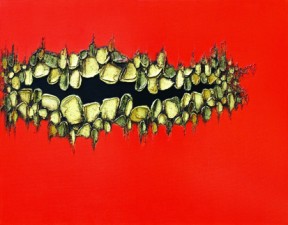When a gallery moves out of its premises – to host a show at an external venue – for the first time in 56 years – one knows for sure that the show has to be something rare and important. Kumar Gallery, which is one of the oldest galleries in the city having started in 1955, is exhibiting a rare collection of paintings by late Sohan Qadri, a master abstractionist known for his tantric symbolism. Titled Sohan Qadri – A Retrospective: Important Paintings from 1961-2010, the show will begin on September 1, 2011 till September 6, 2011 at the Visual Arts Gallery in New Delhi.
Says Sunit Kumar, Director, Kumar Gallery: “Our Sunder Nagar gallery could not have done justice to the scale and expanse of this show. The exhibition-cum-tribute presents works by one of India’s most renowned and internationally acclaimed abstract artists, the late Sohan Qadri who passed away in Toronto in March 2011 at the age of 79. This is perhaps the largest body of work ever seen on Qadri spanning six decades of his art practice and includes oil on canvas as well his favourite medium of ink and vegetable dyes on paper. We will also be launching the first major art book on him covering his entire oeuvre.”
Among the early abstractionists introduced by Kumar Gallery were V.S Gaitonde, Biren De, Ram Kumar and G.R.Santosh. Sohan Qadri who joined this group in 1963 remained true to his direction, ever evolving and further revealing his spirit and soul in his works. Throughout his oeuvre, Qadri reflected an intense personal journey, enhanced and inspired by the depths of his own painterly inner realm. An artist, poet and vajrayan tantric teacher, Qadri loved to create symbols, which for him meant energy or Shakti which moves. He disliked creating figurative visuals as according to him “they destroy the painting”. With no formal training in art, he made his own colours and preferred to work on paper.
Among Indian abstractionists, Sohan Qadri has an important place. He not only used signs reminiscent of tantrik and ritual symbolism, but his work appeared to resonate with the theories of colours and their psychological effect based on the principles of an aesthetic of moods or rasas. Moreover, the visual flowering of his works in this genre is connected with years of practicing the physical and mental discipline of Sufis and tantriks, two of whom he came into contact with, in his home village of Chachoki near Phagwara in Punjab. His stay in Africa, Europe and the USA over the years added its own richness to his work. This gave him the capacity to blend the various forms of mystic ritual with an original visual expression of an artist who was very much a “citizen of the world” as well.
Perhaps the man who understood this best was painter F.N. Souza, himself one of the best the last century has produced. He is supposed to have said once: “There are artists. There are tantriks. There are tantrik artists. As far as I know, there are no tantrik yogis who are artists as well. Sohan Qadri is an exception. He is an exceptional artist”.
The most challenging thing in Qadri’s art is its technique. His works are to be seen back to front. He allowed the colour to percolate through the thick hand-made paper he painted on, allowing forms to develop on the other side, that he then textured by tearing and blending the surface. Call them bindus or yonis, but to us they represent an alternative harmony of form and texture. Over the years, his work went through a form of distillation. Colours became lighter and lines became the residue of textures. And the interplay of these reflects the complex compositional structure of his art. It is non-figurative. It is different. It has maturity. It has something deeply within us to say. One cannot ask for more than that from abstract art.






